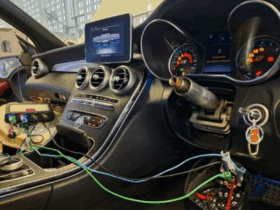Table of Contents
ESP Inoperable Mercedes: Case Study in the Mercedes E300 W212
When the message “ESP Inoperable” appears on the dashboard of your Mercedes-Benz E-Class (W212), it signals a critical fault within the Electronic Stability Program (ESP) one of the car’s most vital safety systems.
ESP ensures stability by detecting and correcting skidding or traction loss during braking or cornering. When inoperative, the vehicle’s ability to maintain control is reduced, especially in emergencies.
This case study outlines how a faulty vacuum pump caused the ESP Inoperable warning in a Mercedes E300 W212, and how the issue was accurately diagnosed and resolved.
For an in-depth overview of all brake-related faults and fixes, visit: Mercedes Brake System Problems: ABS, ESP & Brake Assist Guide
Customer Complaint
Vehicle: Mercedes-Benz E300 (W212)
Reported issue: “ESP Inoperable Mercedes” warning and brake system malfunction.
The owner reported that the brake pedal felt unusually hard and braking performance was poor. This immediately indicated a potential vacuum issue affecting the brake booster and related ESP components.

Diagnostic Process
The technician began by performing a Launch diagnostic scan on the vehicle. Multiple fault codes were stored in the ESP control module, with several indicating insufficient vacuum pressure.

Since the ESP relies partly on vacuum assistance to modulate braking force, any failure in the vacuum circuit can disable the system and trigger the ESP Inoperable warning.
Fault codes observed: Related to vacuum pressure deviation and brake assist system limits.
Investigation & Findings
The investigation focused on the vacuum system. Using a vacuum gauge, the technician verified there was no suction coming from the vacuum pump confirming a total failure.
The mechanical vacuum pump, which supplies vacuum to the brake booster, is essential for effective braking and ESP control. Without it, both the brake assist and stability functions fail to operate correctly.
Repair & Replacement
To restore system functionality:
- 1. The defective vacuum pump was removed and replaced with a new OEM unit.
- 2. All vacuum lines and seals were inspected for leaks or cracks.
- 3. The system was reassembled and the fault codes were cleared using XENTRY.
- 4. A road test was conducted to confirm that braking and ESP systems were functioning normally.
Result: The “ESP Inoperable” warning disappeared, braking performance was restored, and no further faults were present.



Outcome
Replacing the faulty vacuum pump resolved the issue completely.
After the repair:
- – The brake pedal response returned to normal.
- – The ESP system resumed full functionality.
- – The vehicle stability control operated as intended during testing.
The customer left the workshop with confidence in both the repair quality and the restored safety of their vehicle.

Technical Insight: How the Vacuum Pump Affects ESP
The vacuum pump is critical to the brake booster’s operation. It generates the negative pressure that reduces the force needed on the brake pedal and ensures responsive braking.
If the pump fails:
- – Brake assist is lost, resulting in a hard pedal.
- – Insufficient vacuum pressure affects the ESP system’s ability to control wheel slip.
- – The system triggers “ESP Inoperable” or “Brake System Fault” warnings on the dashboard.
Common Symptoms of a Faulty Vacuum Pump
| Symptom | Possible Indication |
|---|---|
| Hard brake pedal | Brake booster not receiving vacuum |
| ESP or brake warning lights | Low vacuum pressure affecting ESP operation |
| Hissing or air-leak noise | Vacuum line or pump leak |
| Reduced braking power | Loss of boost assistance |
| Oil leak near pump area | Seal or housing damage |
Vacuum Pump Maintenance & Replacement Tips
- – Inspect regularly: Especially on diesel and turbocharged engines where the pump runs constantly.
- – Listen for leaks: Hissing or whistling may indicate a vacuum leak.
- – Check connections: Ensure vacuum lines are securely attached and not cracked.
- – Replace faulty pumps immediately: Driving with low vacuum pressure can disable ABS, ESP, and Brake Assist functions.
FAQ: ESP Inoperable Mercedes
Q1: What causes “ESP Inoperable” in a Mercedes?
The most common causes include vacuum pump failure, wheel speed sensor faults, steering-angle sensor issues, or low voltage from the battery.
Q2: Can a bad vacuum pump trigger the ESP light?
Yes. If the vacuum pump fails, the brake assist system loses pressure support, leading to ESP faults or the “Inoperable” warning.
Q3: How can I confirm a vacuum pump fault?
Use a vacuum gauge. A properly functioning pump should generate around -0.7 to -0.9 bar of pressure. If not, replacement is required.
Q4: Is it safe to drive with “ESP Inoperable” on?
No. Your vehicle will have reduced braking assistance and no electronic stability control, increasing accident risk.
Q5: How much does it cost to replace a Mercedes vacuum pump?
Typically between $300–$600, depending on model and labor rates.
Conclusion
This Mercedes E300 W212 case study shows how a vacuum system failure can disable electronic stability and brake assist systems.
By replacing the faulty vacuum pump and verifying system integrity, the ESP Inoperable issue was completely resolved.
Regular inspection of the brake vacuum system can prevent such problems and ensure safe, reliable vehicle performance.
For more brake system case studies and troubleshooting guides, visit: Mercedes Brake System Problems: ABS, ESP & Brake Assist Guide
Author Bio
Mercedes Expert is an automotive technical trainer and Mercedes-Benz diagnostics expert with extensive hands-on experience in XENTRY, DTS Monaco, and advanced system troubleshooting. He specializes in transforming real workshop case studies into structured learning content to help technicians, car owners, and enthusiasts understand complex vehicle systems.
Last update: October 2025






Leave a Reply